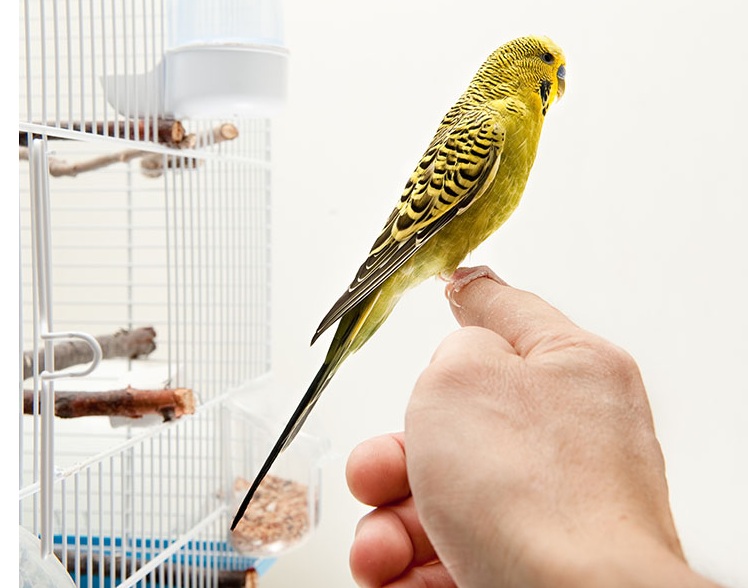How to Tame a Budgie: A Complete Guide to Building Trust and Bonding
Budgies (budgerigars) are among the most popular pet birds worldwide, beloved for their vibrant plumage, cheerful personalities, and remarkable intelligence. These small parrots can learn to mimic human speech and form deep bonds with their owners. Whether you’re a first-time bird owner or an experienced avian enthusiast, learning how to tame a budgie properly creates a foundation for years of companionship and joy.
Taming isn’t just about getting your budgie to perch on your finger—it’s about building trust and establishing a meaningful relationship. This guide will walk you through proven, stress-free methods to tame your budgie at any age.
Understanding Your Budgie’s Behavior
Before beginning the taming process, it’s essential to understand budgie body language and behavior. According to the American Veterinary Medical Association, recognizing stress signals in birds prevents anxiety and builds stronger human-animal bonds.
Signs of Fear or Stress
- Flapping wildly around the cage
- Freezing or retreating to corners
- Fluffed feathers with darting eyes
- Attempting to escape when approached
Signs of Comfort and Trust
- Preening while you’re nearby
- Chirping softly or singing
- Calmly observing their surroundings
- Eating or playing in your presence
Learning to read these signals is your most powerful taming tool. A relaxed budgie is a teachable budgie.
Step 1: Create a Safe and Comfortable Environment
Set Up the Perfect Cage
Start with proper cage setup:
- Size matters: Choose a cage at least 18″ x 18″ x 24″ for one budgie (The Spruce Pets recommends larger spaces for flight)
- Perch placement: Install perches at varying heights using natural wood
- Toys and enrichment: Add 2-3 safe toys, rotating them weekly
- Location: Place the cage in a quiet area where your budgie can observe household activity without being overwhelmed
Give Them Time to Settle
New budgies need 3-5 days to acclimate to their environment. During this period:
- Avoid direct handling attempts
- Maintain a consistent feeding and cleaning schedule
- Speak softly when near the cage
- Move slowly and deliberately around the cage area
Step 2: Build Trust Through Presence
Passive Bonding Techniques
Spend time near your budgie’s cage without direct interaction:
- Read a book aloud nearby (15-20 minutes daily)
- Work quietly at a desk within view
- Hum or play soft music
- Narrate your actions: “I’m refilling your water now” or “Here’s some fresh food”
This vocal consistency helps your budgie associate your voice with positive, predictable events, according to avian behavior research from lafeber.com, a trusted resource for bird care.
The Stationary Hand Method
Once your budgie seems calm with your presence (typically 5-7 days):
- Near the cage: Rest your hand on a table beside the cage for 10 minutes daily
- On the cage: Gently place your hand on the outside of the cage bars
- Inside the cage: After 3-5 days, slowly insert your hand while holding a treat
- Stay still: Don’t reach toward your budgie—let them approach at their own pace
Patience is critical. Some budgies progress in days; others need weeks.
Step 3: Introduce Hand Training with Treats
Choose the Right Treats
Millet spray is the gold standard for budgie training, but variety keeps training interesting:
- Millet spray (the ultimate budgie motivator)
- Tiny pieces of apple or carrot
- Fresh spinach or lettuce leaves
- Occasional sunflower seeds (in moderation)
Treat-Based Desensitization
- Offer treats through cage bars: Hold millet spray near the bars, allowing your budgie to eat while you hold it
- Progress to inside the cage: Once comfortable, offer treats with your hand fully inside the cage
- Associate your hand with rewards: Your hand should mean good things are coming
Sessions should be brief (5-10 minutes) to prevent stress or frustration.
Step 4: Master the “Step Up” Command
Perch Training First
Before finger training, use a wooden perch:
- Hold a dowel or stick perch parallel to your budgie’s feet
- Gently press against their lower chest/belly area
- Say “step up” in a calm, consistent tone
- Reward immediately when they step onto the perch
This teaches the stepping motion without the intimidation of a large hand.
Transitioning to Finger Training
Once your budgie reliably steps onto a perch:
- Position your finger like a perch—horizontal and steady
- Use the same command: “Step up” with consistent tone
- Reward generously: Offer praise and treats immediately
- Practice daily: 2-3 short sessions maintain progress
Remember: stepping onto your finger requires significant trust. Never force it. If your budgie retreats, hold your position calmly and try again later.
Step 5: Supervised Out-of-Cage Time
Once your budgie comfortably steps onto your finger, supervised free flight enriches their life and strengthens your bond.
Budgie-Proof the Room
According to the Association of Avian Veterinarians, household hazards are a leading cause of pet bird injuries. Before releasing your budgie:
- Close all windows and doors
- Cover mirrors (budgies can’t distinguish reflections from open space)
- Turn off ceiling fans
- Remove toxic plants (philodendron, pothos, lilies)
- Secure other pets in separate rooms
- Close toilet lids and cover aquariums
First Flight Session
Start with 10-15 minutes in a small, safe room. Let your budgie explore at their own pace. Call them back to you with treats and positive reinforcement. Gradually increase session length as confidence builds.
Common Challenges and Solutions
My Budgie Bites
Budgie nipping typically signals fear, overstimulation, or boundary-setting—not aggression. When bitten:
- Stay calm: Don’t yell or jerk your hand away
- Avoid punishment: Never tap the beak or scold harshly
- Redirect behavior: Calmly return them to their cage or a neutral perch
- Analyze triggers: Was your hand moving too quickly? Were they already stressed?
A loud reaction can inadvertently reinforce biting as an attention-getting behavior.
My Budgie Won’t Step Up
Possible solutions:
- Ensure your hand is steady—wobbly hands are scary
- Try different times of day when they’re more relaxed
- Go back to perch training to rebuild confidence
- Check if hunger affects motivation (train before meals)
Progress Has Stalled
Taming isn’t linear. Some days bring breakthroughs; others feel like setbacks. This is completely normal. Key strategies:
- Celebrate small wins: Ate from your hand today? That’s progress!
- Maintain consistency: Daily interaction matters more than session length
- Adjust expectations: Older budgies or previously neglected birds need more time
- Take breaks if needed: A day off can reset both you and your budgie
Beyond Taming: Building a Lifelong Bond
Taming is just the beginning. A truly bonded budgie relationship requires:
Daily Interaction
- Talk to your budgie throughout the day
- Include them in household activities safely
- Maintain predictable routines
Mental Stimulation
- Rotate toys every 1-2 weeks
- Introduce puzzle feeders and foraging opportunities
- Teach simple tricks (wave, spin, retrieve objects)
Physical Health
- Provide a balanced diet beyond seeds (petmd.com offers excellent nutrition guides)
- Ensure 10-12 hours of sleep in a covered, quiet cage
- Schedule annual avian veterinary checkups

Frequently Asked Questions
Q: How long does it take to tame a budgie?
Taming timelines vary widely based on the bird’s age, previous experiences, and personality. Young budgies (under 6 months) typically tame within 2-4 weeks with daily practice. Adult or previously neglected budgies may take 2-3 months or longer. Consistency matters more than speed—daily 10-minute sessions outperform sporadic hour-long attempts.
Q: Can I tame an older budgie?
Absolutely! While young budgies adapt faster, adult budgies can absolutely learn to trust humans. Older birds simply need more patience and may progress more slowly. The techniques remain the same—focus on trust-building, positive reinforcement, and respecting their pace. Some adult budgies surprise their owners by bonding quickly once they realize they’re safe.
Q: What are signs my budgie trusts me?
Trust indicators include: eating while you’re nearby, preening in your presence, chirping or singing when you enter the room, stepping onto your finger willingly, grinding their beak contentedly (a sign of relaxation), fluffing and settling down near you, and making soft contact calls to you. The ultimate trust sign? A budgie sleeping or napping while perched on you.
Q: How do I start taming a new budgie?
Begin with a 3-5 day adjustment period where you don’t handle them—just let them observe their new environment. Then progress through: passive presence (spending quiet time near the cage), vocal bonding (talking gently while doing tasks), stationary hand exercises (getting them used to your hand), treat training (offering millet through bars), and finally step-up training. Each phase builds on the previous one.
Q: What’s the best way to bond with a scared budgie?
For anxious budgies, go extra slowly. Sit near their cage and read aloud or work quietly for 20-30 minutes daily. Avoid direct eye contact initially (predators stare at prey). Offer treats by placing them in the cage and walking away—don’t wait for them to eat while watching. Use a calm, soft voice consistently. Most importantly, let them approach you rather than reaching for them. Building confidence takes time, but the bond will be stronger for it.
Start Your Taming Journey Today
Taming a budgie requires patience, consistency, and respect for your bird’s individual personality. Some budgies bond quickly; others need months to fully trust. The effort is absolutely worth it—a tamed budgie becomes a delightful companion who brightens your days with chirps, cuddles, and playful antics.
Remember: taming is a journey, not a destination. Even fully tamed budgies need ongoing interaction and enrichment. Embrace the process, celebrate small victories, and enjoy building a relationship with your feathered friend that can last 10-15 years or more.
Ready to start taming your budgie? Begin with just 10 minutes today spent quietly near their cage. That’s all it takes to start building trust.


